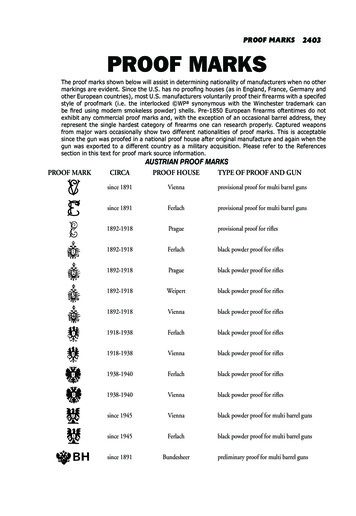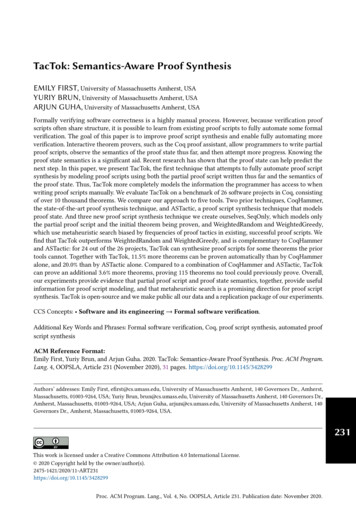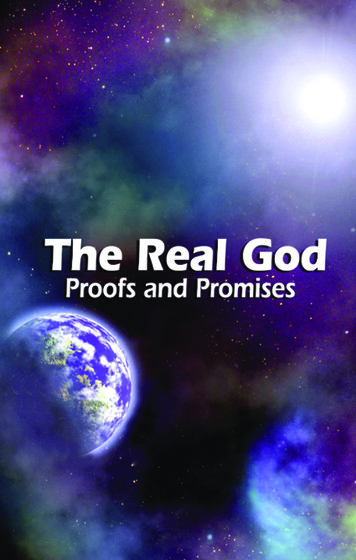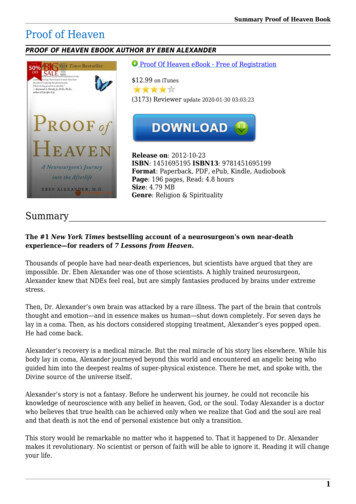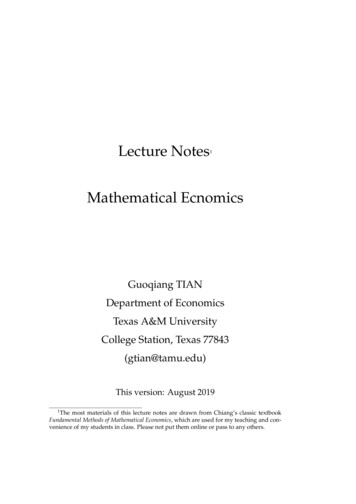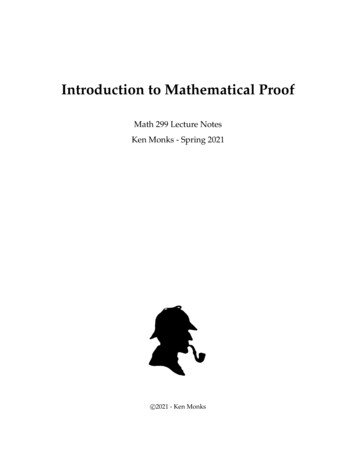
Transcription
Introduction to Mathematical ProofMath 299 Lecture NotesKen Monks - Spring 2021c⃝2021- Ken Monks
Introduction to Mathematical ProofDr. Monks - University of ScrantonContents0 Introduction31 What is a proof?1.1 Formal Proof Systems . . . . . . . . . . . . . . . . . . . . . . . . . . . . . . . . . . . . .1.2 Environments and Statements . . . . . . . . . . . . . . . . . . . . . . . . . . . . . . . .4562 The Language of Mathematics82.1 Identifiers, Variables, and Constants . . . . . . . . . . . . . . . . . . . . . . . . . . . . 82.2 Expressions and Statements . . . . . . . . . . . . . . . . . . . . . . . . . . . . . . . . . 92.3 Substitution and Lambda Expressions . . . . . . . . . . . . . . . . . . . . . . . . . . . 103 Rules of Inference in Mathematics113.1 Template Notation for Rules of Inference . . . . . . . . . . . . . . . . . . . . . . . . . 114 Propositional Logic4.1 The Statements of Propositional Logic . . . . . . . . . . . . . . . . . . . . . . . . . . .4.2 The Rules of Propositional Logic . . . . . . . . . . . . . . . . . . . . . . . . . . . . . .4.3 Formal Proof Style . . . . . . . . . . . . . . . . . . . . . . . . . . . . . . . . . . . . . .131314165 Predicate Logic5.1 Quantifiers . . . .5.2 Statements . . . .5.3 Declarations . . .5.4 Rules of Inference5.5 Equality . . . . .191920202021.2626272728293131313334.6 Proof Shortcuts and Semiformal Proofs6.1 Use Theorems as Rules of Inference . . . . . . . . . . . . . . . . . . . . . . .6.2 Substitute Logically Equivalent Expressions . . . . . . . . . . . . . . . . . .6.3 Use Famous Logic Theorems Freely . . . . . . . . . . . . . . . . . . . . . .6.4 Identify Certain Statements . . . . . . . . . . . . . . . . . . . . . . . . . . .6.5 Skip Some Logical Rules of Inference . . . . . . . . . . . . . . . . . . . . . .6.6 Omit Most Premise Citations, Line Labels, and End-of-Subproof Symbols6.7 Eliminate Extra Parentheses for Associative Binary Operators . . . . . . .6.8 Combine consecutive rules . . . . . . . . . . . . . . . . . . . . . . . . . .6.9 Use Transitive Chains! . . . . . . . . . . . . . . . . . . . . . . . . . . . . . .6.10 Use Derived Rules of Inference . . . . . . . . . . . . . . . . . . . . . . . . .7 The Natural Numbers367.1 The Peano Postulates . . . . . . . . . . . . . . . . . . . . . . . . . . . . . . . . . . . . . 36c 2021 KEN MONKS⃝PAGE 1 of 90
Introduction to Mathematical Proof Lecture Notes7.27.37.4Strong Induction . . . . . . . . . . . . . . . . . . . . . . . . . . . . . . . . . . . . . . . 36Number Theory . . . . . . . . . . . . . . . . . . . . . . . . . . . . . . . . . . . . . . . . 37Applications: Cardinal and Ordinal Numbers . . . . . . . . . . . . . . . . . . . . . . . 398 Sequences8.1 Finite and Infinite Sequences . . . .8.2 Representations of Sequences . . . .8.3 Reindexing . . . . . . . . . . . . . . .8.4 Recursive Definitions and Sequences.42424244459 Integer, Rational, and Real Numbers9.1 Notation . . . . . . . . . . . . . . . . . . . .9.2 The Axioms for Real Numbers . . . . . . .9.3 Basic Properties of Real Numbers . . . . . .9.4 Integers . . . . . . . . . . . . . . . . . . . . .9.5 Extending Definitions . . . . . . . . . . . .9.6 Infinite Series and Decimal Representation.50505052545557.10 Sets, Functions, Numbers10.1 Basic Definitions from Set theory . . . . . .10.2 Shortcuts involving sets . . . . . . . . . . .10.2.1 Use Typed Declarations . . . . . . .10.2.2 Use Extended Set-Builder Notation10.3 Famous Sets of Numbers . . . . . . . . . . .10.4 Functions . . . . . . . . . . . . . . . . . . . .10.5 Relations . . . . . . . . . . . . . . . . . . . .585862626364667211 Expository Proofs11.1 Traditional Proofs . . . . . . . . . . . . .11.2 Specific Rules for Mathematical Writing11.3 Notation . . . . . . . . . . . . . . . . . .11.4 Syntax . . . . . . . . . . . . . . . . . . .11.5 Equations and Formulas . . . . . . . . .11.6 Writing Technique . . . . . . . . . . . . .11.7 Mathematical Typesetting . . . . . . . .777878787981828312 Combinatorial Proofs12.1 Combinatorics . . . . . . . . . . . . . . . . . . . . . .12.2 Combinatorical Collections and Expressions . . . .12.3 Combinatorial Proofs . . . . . . . . . . . . . . . . . .12.4 Combinatorial subtraction, division, and inequality.8484848586c 2021 KEN MONKS⃝.PAGE 2 of 90
Introduction to Mathematical Proof Lecture Notes0IntroductionThe development of logic and mathematics over thousands of years is one of the great achievementsof human cognition.On the one hand, its usefulness and practical importance in the modern world is hard to overstate.It provides a foundation upon which science, engineering, finance, medicine, economics, computerscience, agriculture, and many other areas of human knowledge have been developed. But thisfact raises an interesting question. Why?Why is it that such a wide and disparate collection of applications from counting to cosmologyall rely upon mathematics? Why are they built upon mathematics instead of something else like,say, music or poetry? Most of us recognize that mathematics is exceedingly useful, but why is it souseful?One possible reason is that it provides us with a reliable starting point on which to build consensus.A group can accomplish much more by working collaboratively than they can by working asseparate individuals. But cooperation and collaborative decision-making require a consensusabout the assumptions, terminology, and facts that allow us to communicate and inform ourdecisions.Mathematics and its underlying logic provide us with a tool that allows us to reason in a waythat is reliable, objectively verifiable, and independent of our individual, personal, and subjectivehuman biases. Mathematicians do not debate whether 5 is larger than 4, or whether 2 3 5.The fact that mathematics can be verified objectively and reliably is what makes it a prototype forachieving consensus about mathematical facts. Other disciplines that can successfully build uponmathematics can then use it to construct a solid foundation for consensus about facts in their ownsubject area.In addition to being useful, mathematics is one of the most beautiful, creative, and sublime creationsof the human mind. It is inherently valuable for its own sake as a work of art, to be enjoyed andshared with others, and passed down from generation to generation for thousands of years.For this reason, our introduction to mathematical proof must combine both the rigorous objectivitythat is needed for determining and communicating mathematical facts, with the elegance andbeauty that exemplifies any human art form.The main reason mathematics and logic are so amenable to building consensus is that anyone cancheck a mathematical claim for themselves. There is no need to believe anyone, cite any book, orconsult any oracle. We can each take personal ownership of our mathematics by proving all of itourselves.The goal of this course is to do exactly that. It will guide you on a personal journey to build andverify most of elementary mathematics from the ground up. It is a quest to objectively prove foryourself all of the basic elementary mathematical facts about logic, natural numbers, sequences,real numbers, set theory, functions, relations, and combinatorics.To accomplish this, we must begin by slowly and carefully defining exactly what constitutes amathematical proof, how to construct them ourselves, and how to express them up in a way thatallows them to be accurately shared them with others.c 2021 KEN MONKS⃝PAGE 3 of 90
Introduction to Mathematical Proof Lecture Notes1What is a proof?Simply statedA proof is an explanation of why a statement is objectively correct.Thus, we have two goals for our proofs. Veracity - we want to verify that a statement is objectively correct. Exposition - we want to be able to effectively and elegantly explain why it is correct.However, these two goals are sometimes in conflict. So how to achieve both?The Proof SpectrumTo be certain that our proof is correct, we need to be exceedingly careful and rigorous. To be clearin our exposition, we need to be succinct and elegant.To obtain elegant clarity without sacrificing correctness, we will begin with proofs that are objectively correct by virtue of the fact that they can be verified by a machine. This style of proof iscalled a formal proof. Then we will use a well-defined set of proof shortcuts to eliminate tedious,repetitive, and uninteresting parts of our proofs. Thus, we will construct a bridge between ourformal proofs and the more traditional proofs found in journals, textbooks, and problem solutions.Figure 1: The Proof SpectrumRigor and EleganceOn the one hand, mathematical proofs need to be rigorous. Whether submitting a proof to amath contest or submitting research to a journal or science competition, we naturally want it to becorrect. One way to ensure our proofs are correct is to have them checked by a computer. (Notec 2021 KEN MONKS⃝PAGE 4 of 90
Introduction to Mathematical Proof Lecture Notesthat checking to see if a proof is correct is much easier for a computer to do than finding a proof inthe first place.)There is much discussion in mathematics today about the value of computer verified proofs andtheir counterparts - rigorous, detailed, formal proofs. Mathematicians and computer scientistssuch as Vladimir Voevodsky and Leslie Lamport have been making a strong case for formal,rigorous, computer-verified proofs.On the other hand, most mathematicians are attracted to mathematics because of its intrinsicbeauty. A proof that communicates the key ideas of a proof to the reader in a succinct andbeautiful way is very effective for its expository properties, even if it is not as rigorous as a formalproof. The legendary mathematician Paul Erdös always spoke of “The Book”, an imaginary bookin which God had written down the best and most elegant proofs for mathematical theorems.When he saw any particularly inspiring proof, he would exclaim “That proof is from ‘The Book’!”We will strive for both rigor and elegance in our proofs by building a bridge between highlyrigorous formal proofs and more elegant traditional proofs. We begin with formal proofs."Math is a cross between art and law. Law is about the reasoning and proving. And the artis because what we’re trying to prove are statements that are somehow elegant. That’s wherethe artist decides what is art." - US IMO Coach Po-Shen Loh, after his team won the 2015IMO1.1Formal Proof SystemsWe begin on the left hand end of the bridge by defining a formal proof system that we will use inthis course.Definition 1. A Formal Proof System (or Formal Axiom System) consists of1. A set of expressions called statements.2. A set of rules called rules of inference.Each rule of inference has zero or more inputs called premises and one or more outputs calledconclusions. Most premises and all conclusions of a rule of inference are statements in the system.1There also may be conditions on when a particular rule of inference can be used.Definition 2. An axiom is a conclusion of a rule of inference that has no premises.Definition 3. A statement Q in a formal axiom system is provable from premises Q1 , . . . , Qn if1. Q is a conclusion of a rule of inference when P1 , . . . , Pk are the premises, and2. for each 1 i k, if Pi is a statement, then Pi is provable from Q1 , . . . , Qn .In particular, if Q is an axiom, then Q is provable from no premises at all!Definition 4. If Q follows from no premises in a formal axiom system, we say that Q is provable inthe system. A provable statement is called a theorem.1Other common premises are variable declarations, constant declarations, and subproofs.c 2021 KEN MONKS⃝PAGE 5 of 90
Introduction to Mathematical Proof Lecture NotesAnd finally, the definition we’ve all been waiting for!Definition 5. A proof of a statement in a formal axiom system is a sequence of applications of therules of inference (i.e., inferences) that show that the statement is a theorem in that system.1.2Environments and StatementsThe set of statements in the formal systems used in mathematics are generally some syntacticallywell-defined collectionof expressions. In some systems, the statements may be purely symbolic, such as “ 1 2 ” or “ (A B)′ A′ B′ ”. In others, the statements may be English sentences,such as “The number 2021 is the product of two consecutive primes.” or “Every set of naturalnumbers has a least element.”.We frequently organize the sentences in a book by collecting them together into nested hierarchicalstructures called chapters, sections, subsections, and so on. Similarly, statements in mathematicsare also frequently organized by placing them into nested hierarchical structures called environments or contexts. A math textbook can also have environments such as chapters, sections,subsections, but will also frequently contain other more specialized mathematical environments,called theorems, proofs, subproofs, definitions, declarations, examples, and many others.Environments serve two main purposes. First, as the name suggests, an environment provides acontext that delineates where certain assumptions or definitions are assumed to be under consideration. For example, if the author says in Chapter 1 of a book, “In this chapter we will assumethat n is a positive integer.”, then the reader would not normally assume that the same assumptionabout n holds in Chapter 2.Second, the rules of inference of many formal systems can also use environments as inputs andoutputs in addition to statements. We will encounter several examples of this later on, but for nowthere is one kind of environment that will be almost immediately useful and necessary.Notation. If Q is provable from premises P1 , . . . , Pn in a formal system we can denote this symbolically asP1 , . . . , Pn QThis expression is defined to be a kind of environment, which we will call a proposition or subproof.Each of the variables in the expression can be either a statement or another environment. Suchexpressions can also have multiple conclusions, Q1 , . . . , Qm , in which case we can write them asP1 , . . . , Pn Q1 , . . . , QmYou can think of such an expression as saying that Q can be proven in the current context if wetemporarily add P1 , . . . , Pn as axioms to the currently available rules of inference. Note that thepremises to the left of the are not in any particular order and duplicates are redundant, so neednot be listed (i.e., it is a set of premises, not a list). The same is true for the conclusions on the right.LurchLurch is a word processor that allows you to define your own formal axiom systems and checkyour proofs in that system! Check it out at lurchmath.org.c 2021 KEN MONKS⃝PAGE 6 of 90
Introduction to Mathematical Proof Lecture NotesProblemsToy ProofsThere are several examples of simple Formal Proof Systems available online atproveitmath.org/toyproofs1.1. Scrambler! is a formal proof system where the statements are finite sequences of colors. TheRules of Inference are permutations of these sequences (and so have one premise and oneconclusion each). The goal is to apply the Rules to show that a given sequence of colors isprovable from another given sequence of colors.Try to find a strategy for reliably beating each of the difficulty levels (Weeny, Easy, Fun, ThreeRing Circus, Frogs, Dizzy, Mutant Frogs, and Death!) of Scrambler! They are listed in increasingorder of difficulty. Warning: it can be both addictive and hard!1.2. Trix Game is a formal proof system where the statements are positive integers. There are onlytwo Rules of Inference, both of which take a single positive integer as a premise, and return asingle positive integer as their conclusion. This system illustrates a rule that has a conditionon when you can use it. The goal is to show that a given positive integer is provable from thepremise 1 in the system.Try to find a strategy for winning. Warning: if you can prove that you will always win thisgame no matter what integer you have for the goal, you will win money and be famous forever!1.3. Circle-Dot is a formal proof system where the statements are just finite sequences of one ormore circles and dots. This formal system has many of the features in common with actualmathematical formal axiom systems. There are five rules of inference, two of which are axioms.The goal is to prove various circle-dot strings in the system.(a) Try to prove Theorem A thru Theorem R in the Circle-Dot web application.(b) Bonus: Can you explain why every circle-dot expression can be proven in the Circle-Dottoy system, or if not, determine with absolute certainty exactly those expressions whichcan?1.4. Define a toy formal system as follows. The statements can be any finite string of one or morecharacters, and there are two rules of inference.Rule 0: Given no premises (inputs), we can conclude (output) the string FLM.Rule 1: Given any two strings as premises (inputs), we can conclude (output) theirconcatenation.Notice that Rule 0 is an axiom.(a) What are the theorems in this system?(b) What statements can be proven from the statement GS?(c) List all statements that can be proven from the GS and LTR that are less than 10 characterslong.c 2021 KEN MONKS⃝PAGE 7 of 90
Introduction to Mathematical Proof Lecture Notes1.5. Define a toy formal system as follows. The statements are all nonempty words that onlycontain the character . There are two rules of inference.Rule 0: Given no premises, we can conclude the string .Rule 1: Given no premises, we can conclude the string .Rule 2: Given any two strings as premises, we can conclude their concatenation.(a) Prove all theorems that are less than 12 characters long.(b) What are all of the theorems in this system?1.6. Define a toy formal system as follows. The statements are all words that begin with zero ormore copies of the letter Y followed by one or more copies of the letter X. There are three rulesof inference.Rule 0: Given no premises, we can conclude X.Rule 1: Given any premise, we can conclude the string formed by replacing every Y withYY and every X with XX.Rule 2: Given any premise that has XXX either at the start of the string or immediatelyfollowing a Y, we can conclude the string formed by replacing that occurrance of XXX withY.Rule 3: Given any premise that contains exactly two Xs, we can conclude the string formedby deleting one of the two Xs and then replacing every Y with XX.For example, if you have YYYXX as a premise in Rule 3, then you could conclude XXXXXXX.(a) Prove XXXXX.(b) Prove YY.(c) Prove YYX.(d) What do you think the theorems are in this system?2The Language of MathematicsWe will write our proofs in the language of mathematics. In this section, we give an overview ofthe major building blocks of this language. These will be defined more rigorously as they comeup in actual formal systems.2.1Identifiers, Variables, and ConstantsOne of the first things we learn as children is how to name things. In mathematics, the nameswe give to our ideas and structures are strings or symbols we will call identifiers. Whenever wedefine a formal system, we can specify which strings and symbols are the identifiers in that system.Identifiers in mathematics come in two flavors, constants and variables.c 2021 KEN MONKS⃝PAGE 8 of 90
Introduction to Mathematical Proof Lecture NotesA constant can be thought of as an identifier that names a fixed, specific mathematical entity.Common examples of constants you have encountered in previous math courses like calculus arethings like ‘7’, "π", ‘ln’, ‘cos’, ‘ ’, and ‘ ’. They name a particular number or function or relation.A variable, on the other hand, can be thought of as a name for an unspecified individual mathematical entity, usually of a certain type. The most common identifiers used for this purpose inmathematics are a single lower case letter, upper case letter, or Greek letter, such as ‘x’, ‘P’, or ‘α’.2.2Expressions and StatementsIdentifiers can also be combined in various ways to form larger mathematical expressions. Asingle identifier is called an atomic expression. A mathematical expression comprised of more thanone identifier is called a compound expression. The same identifier might appear more than oncein a compound expression. Like variables, expressions will frequently represent a mathematicalobject of a certain type.For example, you may have seen expressions such as ‘y x 1’. This compound expressioncontains two variables, ‘x’ and ‘y’, and three constants, ‘ ’, ‘ ’, and ‘1’.In addition to indentifiers, mathematical expressions often use punctuation and formatting to formexpressions that are easier to read, or to distinguish or identify two expressions. Common punctuations used in mathematical expressions include parentheses, elipses, and commas. Commonformatting used includes superscripts, subscripts, and arranging expressions into columns or grids n n 1in various ways. For example, we use expressions like ‘ nn xn n 1x · · · n0 ’, ‘a0 , a1 , . . . , an ’,and 1 0 0 1 Mathematical expressions can also contain English words in addition to symbols. For example,you may have seen piecewise functions defined by an expression like n if n is even 2T(n) 3n 1otherwise2Indeed, many mathematical expressions will consist entirely of English words. For example,‘Thehypotenuse is the longest side of a right triangle.’ is one such expression.As we embark on our journey to build mathematics from the ground up, we will say exactly whichmathematical expressions constitute the statements in the formal systems we define. Generallyspeaking, statements will be mathematical expressions which can be said to be true or false –expressions which if you said them in a courtroom during a trial, a lawyer could accuse you oflying or telling the truth.For example, expressions like ‘2 3’, ‘1 1 3’, and ‘Every set is a subset of itself.’ are usuallystatements in mathematics because they are either true or false, whereas expressions like ‘ 12 ’, ‘2 2’,or ‘ ABC’ are not. Notice, however, that we do not need to know whether a statement is true orfalse to know that it is a statement. For example, ‘x 2’ is true if x represents the number 1 butfalse if it represents the number 2. Either way, we can say that the expression ‘x 2’ is either trueor false, and therefore can be considered a statement.c 2021 KEN MONKS⃝PAGE 9 of 90
Introduction to Mathematical Proof Lecture Notes2.3Substitution and Lambda ExpressionsWe can prefix any expression E to form the expression ‘λx, E’ to indicate that all occurrences2 ofthe variable x in E represent the same unspecified object of the same type as x. These prefixedexpressions are called lambda expressions (or anonymous functions).Such expressions can be applied to an expression a having the same type as x to form a newexpression, (λx, E)(a) which has the same type as E. These can be evaluated to form the expressionobtained by replacing all occurrences3 of x in E with (a)4 . If we give a name to a lambda expression,e.g., if we define f to be λx, E then the expression (λx, E)(a) is just the usual notation for functionapplication f (a). In this situation we refer to a as the argument of the lambda expression application.For example, (λx, x3 )(a) evaluates to a3 . Indeed, in many math textbooks they will write f (x) x3instead of writing f (λx, x3 ), but the latter is usually what they mean. In this example, we wouldhave the usual evaluation of functions, e.g., f (a) a3 , f (2) 23 , and f (x 1) (x 1)3 .Notice that simply replacing all occurrences of x in λx, E with another identifier that does notappear in E produces a new lambda expression which evaluates to the same thing as the originallambda expression when applied to the same argument.Problems2.1. Evaluate the following expressions.(a) (λx, x2 x 1)(3)(g) (λy, cos(x) sin(y))(1)(b) (λx, x2 x 1)(s)(h) λx, (λy, cos(x) sin(y))(1)(c) (λx, x2 x 1)(s2 s 1)(d) (λx, 5)(t)(e) (λx, 5)(t 1)(f) (λx, cos(x) sin(y))(1)(i) (λx, (λy, cos(x) sin(y))(1))(2)(j) (λT, T is isosceles)(ABC)(k) (λT, T is isosceles)(DEF)2.2. Let f be λn, 2 · n and let g be λn, n 2. Evaluate the following.(a) f (k)(f) g(g(k))(b) g(k)(g) f (g(k 1))(c) f (g(k))(h) g( f (k 1))(d) g( f (k))(i) f ( f (k 1))(e) f ( f (k))(j) g(g(k 1))2These refer to free occurrences – see section 5.1.Also no free identifier in a should become bound as a result of the substitution – see section 5.1.4in many situations the parentheses around a can be omitted for clarity3c 2021 KEN MONKS⃝PAGE 10 of 90
Introduction to Mathematical Proof Lecture Notes2.3. Suppose we have the following named lambda expressions.λW, λV, (WV, VW W)(R1 )λW, λ(V, W, V W V)(R2 )λW, λV, (WV W#)(R3 )Evaluate the following.3(a) (R1 ( ))(#)(d) R1 ( # )(b) (R2 ( ))(#)(e) R2 ( # )(c) (R3 ( ))(#)(f) R3 ( # )Rules of Inference in MathematicsIn the Circle-Dot system, Axiom A is a rule of inference that says from no premises we can conclude# . Rule 1, however, is technically not a rule of inference, but rather an infinite family of rulesof inference, one for each choice of circle-dot strings we can substitute for the variables W and V.From this perspective, we can think of Rule 1 as the lambda expression,λW, λV, (WV, VW W)So that, for example, substituting # for W and for V produces the rule(λW, λV, (WV, VW W))(#)( ) (λV, (#V, V# #))( ) (# , # #)which allows us to conclude # from the premises # and # .Most rules of inference in mathematics are more similar to Rule 1 than to Axiom A in this sense –they are really lambda expressions which generate an entire family of specific rules of inference,one for each choice of variable in the statement of the rule. Because this is so common, we usuallyomit the lambda prefixes, and use the convention that any variable W that appears in the premisesor conclusion of a rule of inference can be replaced with an expression of the same type to form aparticular instance of that rule of inference.3.1Template Notation for Rules of InferenceWhile the turnstile notation for rules of inference like the Circle-Dot rule above is very compact, itis helpful to write our rules of inference in notation that looks more like the way will be used in aproof. We can do this by writing thenm in the form of a template that we can fill in when usingthe rule to justify a statement in our proof.To accomplish this we define another notation for the kinds of rules of inference we will encounterin mathematics.Notation. A rule of inference having premises P1 , . . . , Pk and conclusions Q1 , . . . , Qn can be expressed in template notation or recipe notation asc 2021 KEN MONKS⃝PAGE 11 of 90
Introduction to Mathematical Proof Lecture NotesRule Name HereP1.(show)Pk(show)Q1.(conclude)Qn(conclude).In this notation, the rule looks like a template that we can fill in to create our proofs. In particular,the lines marked with a (show) need to be justified with a rule of inference that is supplied asa reason for that line, and those marked with (conclude) can be justified with the given rule ofinference.Some rules of inference have a premise of the form(P1 , . . . , Pk Q)This is not a statement in the formal system itself, but rather the assertion that Q can be provenfrom P1 , . . . , Pk in the formal system. We call an expression of this form a subproof or environment.Such a premise is satisfied by including a subproof in a proof that shows that Q can be provedfrom the given premises (which do not need to be justified by a rule of inference). We denote thisin recipe notation as an indented ‘assume-block’ as illustrated below.Example 6. Suppose we have a rule of inference that justifies the following.W or V, (W U), (V U) Uwhere W, V, and U are any mathematical statements. Then we would express this rule in recipenotation asProof by CasesW or VAssume WU Assume VU (show)(show)(show).U(conclude)In this, everything between an Assume and the following (the ‘end assumption’ symbol) is ac 2021 KEN MONKS⃝PAGE 12 of 90
Introduction to Mathematical Proof Lecture Notessubproof that demonstrates the corresponding premise in the rule of inference. We indent suchassumption blocks in our proofs. Subproofs can be nested, and the level of indentation correspondsto the level of nesting. Assumptions (lines that start with Assume) do not need to be justified bya rule of inference. We say that they are given. Lines marked with (show) must be justified. Linesmarked with (conclude) are justified by the rule itself.Note that we do include the word "Assume " in the proof itself, but not the words "show" or"conclude" which are just instructions to the proof author (as opposed to the reader) for how tojustify the indicated lines.4Propositional LogicWe now turn our attention to a formal axiom system that is based on one first formulated byGerhard Gentzen in 1934 as a formal system that closely imitates the way mathematicians actuallyreason when writing traditional expository proofs.4.1The Statements
Introduction to Mathematical Proof Lecture Notes 1 What is a proof? Simply stated A proof is an explanation of why a statement is objectively correct. Thus, we have two goals for our proofs. Veracity - we want to verify that a statement is objectively correct. Exposition - we want to be able to effectively and elegantly explain why it is correct. However, these two goals are sometimes .
